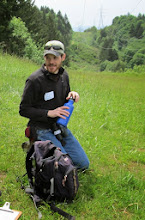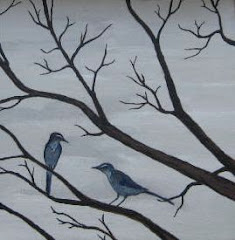
What explains this diversity? I believe that these forests contain a unique set of habitat features that create a woodpecker paradise.

First, the east Cascade forests have unique tree communities that change with the elevation. This provides numerous foraging sites, allowing species to coexist.
Second, many large snags (dead trees) can be found throughout the forest. Woodpeckers excavate nesting cavities in snags and some species use cavities previously carved by other species.
Third, there are many quaking aspen trees in the wetter parts of the forests. These trees have relatively soft wood and some woodpecker species can excavate cavities in live aspens.
Fourth, large and abundant ponderosa pines provide nesting and foraging sites when they are live or dead. Some woodpeckers, such as the Williamson’s sapsucker and white-headed woodpecker, rarely occur outside ponderosa forests.

Finally, central Oregon has frequently occurring wildfires, which benefit woodpeckers, perhaps more than any other group of birds. Research has shown that many species of woodpeckers reach their highest abundances in burned forests and have greater nesting success in wildfire sites than in unburned sites. Individuals of one species, the black-backed woodpecker, spend nearly all of there time in wildfire sites and rarely nest anywhere else.
With all of this in mind, Sarah and I were eager to spot as many woodpeckers as possible during our vacation last week. We have seen most of the woodpecker species before, but I have never seen a three-toed woodpecker and Sarah had never seen a Williamson’s sapsucker, a three-toed, or a black-backed woodpecker. We were happy to see any species, but these three were at the top of our list.

Also high on our list was the white-headed woodpecker (photo above from the Washington State website), a mime-looking, declining species whose range is largely confined to central Oregon, Washington, and California.
As we set up our camp at Cold Springs Campground, we heard the distinctive, rattling call of a white-headed woodpecker. We soon spotted one on the trunk of a skinny ponderosa sapling.

After a chilly night, I heard more woodpecker calls serving as a natural alarm clock. As I walked Andie the Dog, I heard the rattle again and spotted a pair of white-headeds on side-by-side saplings. I also spotted a brownish, silent woodpecker on an adjacent tree. I ran back to the tent to get Sarah and we relocated the bird and identified it as a juvenile female Williamson’s sapsucker. The plumages of males and females of this species are so different that they were once considered separate species. The individual we saw looked like a tiny flicker due to the barring on the back.

A few days later, we found an adult male at Shevlin Park in Bend.
 We looked for more species along the Metolius River, where I once spotted a pair of black-backs,. We saw only a few hairy woodpeckers, good birds in their own right.
We looked for more species along the Metolius River, where I once spotted a pair of black-backs,. We saw only a few hairy woodpeckers, good birds in their own right. The color of the spring-fed Metolius was amazing, as always. This dipper was enjoying the light show under a bridge.
The color of the spring-fed Metolius was amazing, as always. This dipper was enjoying the light show under a bridge.
We drove to a wildfire site hoping to find more species, especially three-toeds and balck-backs. The nice folks at the US Forest Service Station in Sisters told us where to find a site that burned last year.
It did not take us long to hear tapping and we spotted the source: a red-breasted sapsucker. We see this species fairly often at low elevations in western Oregon, so it was a bit of a surprise to see one high in a wildfire site.

It was hard at work carving wells in this subalpine fir tree.
In all, we spotted six species of woodpeckers, including a new species for Sarah. I did not get any photos of the birds because I was too busy enjoying them and our camera has no zoom. Since we left a few species begind, we have good reason to return to this great part of the state.






1 comment:
Hi there - I very much enjoyed your post. My very favorite bird is the Red-bellied Woodpecker, and I love woodpeckers in general. Sounds like central Oregon is woodpecker heaven. I have family that lives near Bend, and Albany, so I have an idea of the beauty in the area. Thanks for sharing your trip!
Post a Comment